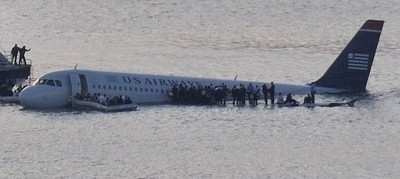Center Will Expand Research, Accuracy, and Availability of
Data
 Embry Riddle notes
that the Jan. 15 ditching of US Airways Flight 1549 in the Hudson
River vividly illustrated the dangers of midair collisions between
birds and aircraft. But what led to the "miracle on the Hudson"
happens more often than the public realizes. Bird and wildlife
strikes cause more than a half-million hours of aircraft down time
and cost U.S. civil aviation more than $500 million annually,
according to a report by the U.S. Department of Agriculture. And
the threat to air safety is on the rise with the expansion of many
wildlife species that are hazardous to aircraft.
Embry Riddle notes
that the Jan. 15 ditching of US Airways Flight 1549 in the Hudson
River vividly illustrated the dangers of midair collisions between
birds and aircraft. But what led to the "miracle on the Hudson"
happens more often than the public realizes. Bird and wildlife
strikes cause more than a half-million hours of aircraft down time
and cost U.S. civil aviation more than $500 million annually,
according to a report by the U.S. Department of Agriculture. And
the threat to air safety is on the rise with the expansion of many
wildlife species that are hazardous to aircraft.
Embry-Riddle Aeronautical University is launching the
International Center for Aviation and Wildlife Risk Mitigation to
help manage this growing hazard. The new Center, based at
Embry-Riddle's Prescott, Ariz., campus, will bring together top
aviation wildlife experts to share and develop new research and
management solutions to reduce the dangers and serve as a resource
to airports around the world.
The Center is an initiative of national wildlife expert Archie
Dickey, an associate professor of aviation environmental science in
Prescott, Ariz., who serves as director. Dickey created and has
managed the FAA's web-based wildlife strike database since 1999.
The FAA site is a compilation of data about aircraft and wildlife
strikes around the country, and data is voluntarily reported by
airport officials.

"We created this Center to support data collection efforts,
develop better solutions to reduce wildlife strike hazards, and
serve as a clearinghouse to share this information with industry
and organizations that need it," Dickey said. "The US Airways
landing in the Hudson River was the wake-up call that we needed to
accelerate our plan to create this Center, which was several years
in the making."
The new Center is designed to be part of a larger comprehensive
overhaul of the U.S. bird strike hazard management system proposed
by industry experts and now under review through the Aviation
Subcommittee of the House Committee on Transportation and
Infrastructure as well as the FAA.
One of the Center's goals is to bring together and leverage
broad industry, academic, and government supporters to gain federal
and state funding to establish the Center as the pre-eminent
national facility for wildlife/bird strike data collection,
research, and development, similar to FAA-sponsored Centers of
Excellence now operating at Embry-Riddle and other
universities.
 The Center is advised
by prominent experts in aviation safety, aerospace engineering,
aviation law, and pilot training. They include Russell DeFusco,
Ph.D., founder of the wildlife management consultancy BASH Inc.;
Paul Eschenfelder, aviation consultant and president of Avion
Corp.; and Ed Cleary, retired FAA wildlife biologist.
The Center is advised
by prominent experts in aviation safety, aerospace engineering,
aviation law, and pilot training. They include Russell DeFusco,
Ph.D., founder of the wildlife management consultancy BASH Inc.;
Paul Eschenfelder, aviation consultant and president of Avion
Corp.; and Ed Cleary, retired FAA wildlife biologist.
Students enrolled in the Aviation Environmental Science degree
program at Embry-Riddle, which Dickey also chairs, will assist with
research at the Center.
The new Center will develop and promote solutions for managing
wildlife around airports and training pilots and airport personnel
to avoid aircraft collisions with birds and wildlife.
Some approaches already show promise, according to Dickey. For
example, certain marine radar has been modified to detect birds
near airports, and the mowing of airport-area grass to a height of
six to 12 inches deters the presence of larger birds.
The Center will work with bird strike committees in North
America and abroad to collect, maintain, and disseminate relevant
data and research. The Center will develop training programs,
management policies, and operational plans regarding aviation and
wildlife risk mitigation to effectively and accurately facilitate
communication with the scientific community, public, media, and
government organizations.
 ANN's Daily Aero-Term (05.05.25): Circle To Runway (Runway Number)
ANN's Daily Aero-Term (05.05.25): Circle To Runway (Runway Number) ANN's Daily Aero-Linx (05.05.25)
ANN's Daily Aero-Linx (05.05.25) NTSB Prelim: De Havilland DHC-1
NTSB Prelim: De Havilland DHC-1 Classic Aero-TV: The Boeing Dreamliner -- Historic First Flight Coverage
Classic Aero-TV: The Boeing Dreamliner -- Historic First Flight Coverage Airborne-NextGen 05.06.25: AF Uncrewed Fighters, Drones v Planes, Joby Crew Test
Airborne-NextGen 05.06.25: AF Uncrewed Fighters, Drones v Planes, Joby Crew Test





